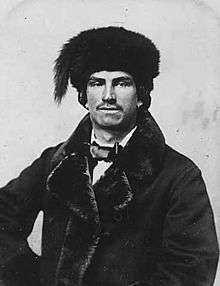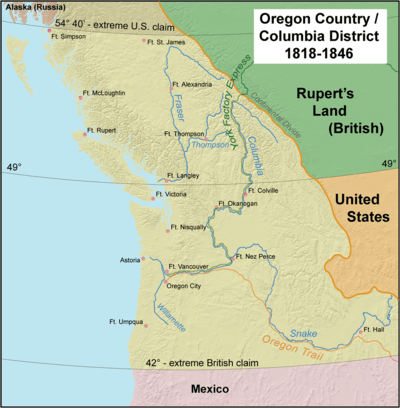Rupert's Land


Rupert's Land, or Prince Rupert's Land, was a territory in British North America, consisting of the Hudson Bay drainage basin, which was nominally owned by the Hudson's Bay Company for 200 years from 1670 to 1870, although numerous aboriginal groups lived in the same territory and disputed the sovereignty of the area. The area once known as Rupert's Land is now mainly a part of Canada, but a small portion is now in the United States of America. It was named after Prince Rupert of the Rhine, a nephew of Charles I and the first Governor of the Hudson's Bay Company. In December 1821 the HBC monopoly was extended from Rupert's Land to the Pacific coast.
Areas belonging to Rupert's Land were mostly in present-day Canada and included the whole of Manitoba, most of Saskatchewan, southern Alberta, southern Nunavut, and northern parts of Ontario and Quebec. It also included present-day United States territory, including parts of the states of Minnesota and North Dakota and very small parts of Montana and South Dakota. The southern border west of Lake of the Woods to the Rocky Mountains was the drainage divide between the Mississippi and Saskatchewan watersheds until the London Convention of 1818 substituted the 49th Parallel.
Fur Trade

In 1670, the Hudson's Bay Company (HBC) was granted a charter by King Charles II, giving it a trading monopoly over the watershed of all rivers and streams flowing into Hudson Bay, an area known as "Rupert's Land" (named in honour of Prince Rupert of the Rhine, the king's cousin and the company's first governor). This covered an area of 3.9 million km2 (1.5 million sq mi), over one-third the area of Canada today.
The Hudson's Bay Company dominated trade in Rupert's Land during the 18th–19th centuries and drew on the local population for many of its employees. This necessarily meant the hiring of many First Nations and Métis workers. Fuchs (2002) discusses the activities of these workers and the changing attitudes that the company had toward them. George Simpson, one of the most noted company administrators, held a particularly dim view of mixed-blood workers and kept them from attaining positions in the company higher than postmaster. Later administrators, such as James Anderson and Donald Ross, sought avenues for the advancement of indigenous employees.[1]
Morton (1962) reviews the pressures at work on that part of Rupert's Land where Winnipeg now stands, a decade before its incorporation into Canada. It was a region completely given over to the fur trade, divided between the Hudson's Bay Company and private traders, with some incursions by the rival North West Company based in Montreal. There was strong business and political agitation in Upper Canada for annexing the territory; in London the Company's trading license was due for review; in St. Paul there was a growing interest in the area as a field for U.S. expansion. The great commercial depression of 1857 dampened most of the outside interests in the territory, which itself remained comparatively prosperous.[2]
Law

Baker (1999) uses the Red River Colony in the "District of Assiniboia" south of Lake Winnipeg, the only non-native settlement on the northwest prairies for most of the 19th century, as a site for critical exploration of the meaning of "law and order" on the Canadian frontier and for an investigation of the sources from which legal history might be rewritten as the history of legal culture. Previous historians have assumed that the Hudson's Bay Company's representatives designed and implemented a local legal system dedicated instrumentally to the protection of the company's fur trade monopoly and, more generally, to strict control of settlement life in the company's interests. But this view is not borne out by archival research. Examination of Assiniboia's juridical institutions in action reveals a history formed less through the imposition of authority from above than by obtaining support from below. Baker shows that the legal history of the Red River Colony – and, by extension, of the Canadian West in general – is based on English common law.[3]
Following the forced merger of the North West Company with the HBC in 1821, British Parliament applied the laws of Upper Canada to Rupert's Land and the Columbia District and gave enforcement power to the HBC. The Hudson's Bay Company maintained peace in Rupert's Land for the benefit of the fur trade; the Plains Indians had achieved a rough balance of power among themselves; the organization of the Métis provided internal security and a degree of external protection. This stable order broke down in the 1860s with the decline of the Hudson's Bay Company, smallpox epidemics and the arrival of trade-whiskey, and the disappearance of the bison. The rule of law was, after the purchase of Rupert's Land by Canada, enforced by the North-West Mounted Police.[4]
Missions
Peake (1989) describes people, places, and activities that were involved in 19th-century Anglican missionary activities in the prairie areas of Rupert's Land, that huge portion of Canada controlled by the Hudson's Bay Company and inhabited by few Europeans. Early in the century, fur trade competition forced the company to expand into this interior region, and some officials saw advantages in allowing missionaries to accompany them. Officially they did not discriminate among denominations, but preference was often granted to the Anglicans of the Britain-based Church Missionary Society. The prairie missions extended from the area of 20th-century Winnipeg to the Mackenzie River delta in the north. Notable missionaries included by David Anderson the first Bishop of Rupert's Land,[5] the inept William Bompas and the Native American Anglican priests: Henry Budd,[5] James Settee and Robert McDonald.[6]
There were also Roman Catholic missions in Rupert's Land. One notable missionary was Alexandre-Antonin Taché, who both before and after his consecration as bishop worked as a missionary in Saint-Boniface, Île-à-la-Crosse, Fort Chipewyan and Fort Smith.[7]
Hudson's Bay Company's surrender of its charter to the Crown
In 1869–1870, the Hudson's Bay Company surrendered its charter to the British Crown, receiving £300,000 in compensation. While it is often said that Hudson's Bay "sold" Rupert's Land as well as the North-Western Territory, the company had no land to sell: its Charter was essentially for a trading monopoly enforceable on British subjects. Control was originally planned to be transferred on 1 December 1869, but due to the premature action of the new lieutenant governor, William McDougall, the people of Red River formed a provisional government that took control until arrangements could be negotiated by leaders of what is known as the Red River Resistance and the newly formed Government of Canada. As a result of the negotiations, Canada asserted control on 15 July 1870.
However, Canada still did not have legal control because the Imperial Crown had made the transfer subject to treaties being entered into with the indigenous nations. While Canada did pass legislation on 12 May 1870 purporting to create the "Province of Manitoba", the absence of the treaties was soon noted, and it was decided in 1873 to pass a second Manitoba Act which would have legal certainty. Other "numbered treaties" followed, and treaty-making extended to the North-Western Territory, which comprised the regions northwest of Rupert's Land and to the north of the Colony of British Columbia.
The transaction was three-cornered. On November 19, 1869, the company surrendered its charter under its letters patent to the British Crown, which was authorized to accept the surrender by the Rupert's Land Act. By order-in-council dated June 23, 1870,[8] the British government admitted the territory to Canada, under s. 146 of the Constitution Act, 1867,[9] effective July 15, 1870, subject to the making of treaties with the sovereign indigenous nations to provide their consent to the Imperial Crown to exercise its sovereignty pursuant to the limitations and conditions of the Rupert's Land documents and the treaties. Lastly, the Government of Canada compensated the Hudson's Bay Company £300,000 ($1.5 million) for the surrender of its charter on the terms set out in the order-in-council.
The company retained its most successful trading posts and one-twentieth of the lands surveyed for immigration and settlement.
See also
- 49th parallel north
- British Arctic Territories
- Canadian canoe routes
- Former colonies and territories in Canada
- Hudson's Bay Company Archives
- Royal eponyms in Canada
References
![]() This article incorporates text from a publication now in the public domain: Morice, Adrian Gabriel (1912). "Alexandre-Antonin Taché". In Herbermann, Charles. Catholic Encyclopedia. 14. New York: Robert Appleton.
This article incorporates text from a publication now in the public domain: Morice, Adrian Gabriel (1912). "Alexandre-Antonin Taché". In Herbermann, Charles. Catholic Encyclopedia. 14. New York: Robert Appleton.
- ↑ Fuchs, Denise. "Embattled Notions: Constructions of Rupert's Land's Native Sons, 1760 To 1861". Manitoba History. Manitoba Historical Society. 2002–03 (44): 10–17. ISSN 0226-5036.
- ↑ Morton, W. L. (Autumn 1962). "Red River on the Eve of Change, 1857 to 1859". The Beaver (293): 47–51. ISSN 0005-7517.
- ↑ Baker, H. Robert (1999). "Creating Order In The Wilderness: Transplanting the English Law to Rupert's Land, 1835–51". Law and History Review. American Society for Legal History. 17 (2): 209–246. doi:10.2307/744011. ISSN 1939-9022.
- ↑ Spry, Irene M. (1968). "The Transition from a Nomadic to a Settled Economy in Western Canada, 1856–1896". Transactions of the Royal Society of Canada. 6 (4): 187–201.
- 1 2 Sarah Tucker (1851). "The Rainbow in the North A Short Account of the First Establishment of Christianity in Rupert's Land by the Church Missionary Society: Chapter XIII. Rev. R. and Mrs. Hunt--Summary of the Missions--Ordination of the Rev. H. Budd". London: James Nisbet. Retrieved 12 December 2015.
- ↑ Peake, Frank A. (1989). "From the Red River to the Arctic: Essays on Anglican Missionary Expansion in the Nineteenth Century". Journal of the Canadian Church Historical Society. 31 (2): 1–171. ISSN 0008-3208.
- ↑
 Morice, Adrian Gabriel (1912). "Alexandre-Antonin Taché". In Herbermann, Charles. Catholic Encyclopedia. 14. New York: Robert Appleton Company.
Morice, Adrian Gabriel (1912). "Alexandre-Antonin Taché". In Herbermann, Charles. Catholic Encyclopedia. 14. New York: Robert Appleton Company. - ↑ Rupert's Land and North-Western Territory Order Archived 20 July 2011 at the Wayback Machine.
- ↑ "Constitution Act, 1867 s. 146". Justice Laws Website. Department of Justice. 18 October 2015.
Further reading
- Ens, Gerhard John; Macleod, R. C.; Binnema, Theodore (2001). From Rupert's Land to Canada. University of Alberta. ISBN 978-0-88864-363-6.
- Grant, Cuthbert (1990). The English River Book: A North West Company Journal and Account Book of 1786. McGill-Queen's University Press. ISBN 978-0-7735-6213-4.
- Davis, Richard Clarke (1988). Rupert's Land: A Cultural Tapestry. Wilfrid Laurier Univ\ersity Press. ISBN 978-0-88920-976-3.
- Gillespie, Greg (2007). Hunting for Empire: Narratives of Sport in Rupert's Land, 1840-70. UBC Press. ISBN 978-0-7748-4038-5.
- Hudson's Bay Company. An Ordinance for the More Effectual Administration of Justice, In the Colony of Rupertsland. London: J. Brettell.
- Stubbs, Roy St. George (1967). Four Recorders of Rupert's Land; A Brief Survey of the Hudson's Bay Company Courts of Rupert's Land. Winnipeg, Manitoba, Canada: Peguis Publishers.
- Tucker, Sarah (1851). The Rainbow in the North: a Short Account of the First Establishment of Christianity in Rupert's Land by the Church Missionary Society. London: James Nisbet & Co.
External links
- The Centre for Rupert's Land Studies - The University of Winnipeg
- "Canada Buys Rupert's Land", CBC
Coordinates: 57°00′N 92°18′W / 57.000°N 92.300°W